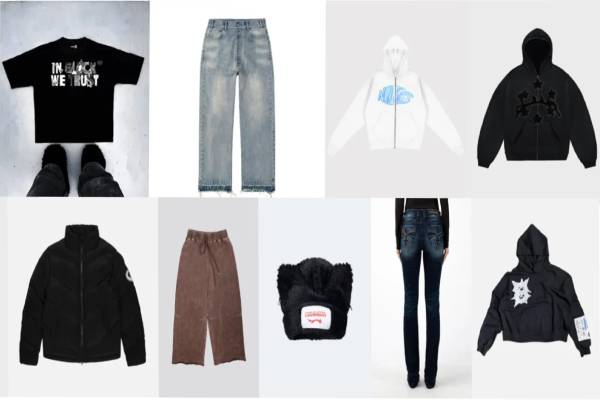In the chaotic world of elective design, where resistance meets imaginativeness, few brands have cleared out an engrave as profound as Drop Dead
Clothing. Made by Oliver Sykes, the frontman of the metalcore band Bring Me The Skyline, Drop Dead was more than fair a clothing label—it was a
development, a way of life, and a image of self-expression for incalculable loners. With its obscurely unusual stylish, DIY ethos, and countercultural request, Drop Dead rapidly picked up a faction taking after. Be that as it may, like numerous specialty brands, it confronted challenges that eventually driven to its suspension. This article investigates the beginnings, affect, and bequest of Drop Dead Clothing in the world of elective fashion.
The Birth of Drop Dead Clothing
Drop Dead Clothing was born out of Oliver Sykes’ energy for craftsmanship, music, and elective culture. Propelled in the mid-2000s, the brand begun as a humble extend, offering hand-printed T-shirts outlined by Sykes himself. With the back of BMTH fans and the quickly developing elective scene, Drop
Dead rapidly changed from a small-scale operation into a fully-fledged design brand. The plans included spooky outlines, dystopian topics, and a
unmistakable blend of emo, punk, and gothic impacts that resounded with defiant youth.
The Rise to Fame
The early victory of Drop Dead was fueled by its association to the music industry. Oliver Sykes, being an powerful figure in metalcore and elective
shake, utilized his stage to advance the brand, turning Drop Dead into an expansion of the BMTH tasteful. The clothing line before long found its way into the closets of fans and individual performers, making a swell impact over the elective mold landscape.
Drop Dead’s offer was assist increased through limited-edition drops, flighty showcasing techniques, and high-quality plans that felt like wearable craftsmanship. The brand wasn’t fair offering clothes—it was offering an personality. From curiously large hoodies decorated with bizarre however lovely
outlines to complicatedly point by point coats, each piece told a story.
Collaborations with major establishments like Sonic the Hedgehog and Jurassic Stop included another layer to the brand’s validity, consolidating
sentimentality with underground mold. The eliteness of these drops made them profoundly looked for after, with things offering out nearly right away. This vital irregularity as it were heightens the crave for Drop Dead pieces, making them collector’s things in the elective mold community.
The Brand’s Special Aesthetic
One of the most characterizing viewpoints of Drop Dead was its interesting visual dialect. Propelled by frightfulness, daydream, and post-apocalyptic subjects, the brand’s plans were frequently unsettling however mesmerizing. Dynamic however dull, chaotic however carefully made, Drop Dead’s
stylish felt like a visual representation of the feelings that fueled elective music.
The brand moreover rejected standard mold standards, grasping larger than average outlines, deconstructed designs, and flighty prints. It obscured the lines between streetwear and tall design, making it a trailblazer in the elective mold scene. The impact of Japanese road design, dystopian sci-fi, and pop culture references made Drop Dead a brand that requested not fair to BMTH fans but to anybody with a taste for the avant-garde.
Challenges and Decline
Despite its solid begin and given taking after, Drop Dead Clothing confronted various challenges as the a long time went by. The elective design industry is famously troublesome to explore, with patterns moving quickly and shopper inclinations advancing. Whereas the brand had a steadfast
fanbase, it battled to reach a more extensive group of onlookers past its specialty market.
The rise of quick design and the expanding availability of elective styles through mass-market retailers too postured a risk to Drop Dead. Brands like H&M and ASOS started joining gothic and punk-inspired components into their collections, advertising comparable aesthetics at lower costs. This competition made it harder for Drop Dead to keep up its restrictiveness without distancing potential unused customers.
Additionally, the limited-edition nature of Drop Dead’s drops, whereas viable in keeping up request, now and then baffled fans who were incapable to secure pieces some time recently they sold out. Over time, these components contributed to a decay in deals and engagement.
In 2023, Drop Dead Clothing declared its closure, checking the conclusion of an period for elective design partners. Whereas the brand’s suspension was met with disillusionment, it too cemented Drop Dead’s bequest as a short lived however extraordinary marvel in the world of elective fashion.
The Faction Bequest of Drop Dead
Though Drop Dead Clothing is no longer in generation, its affect is still profoundly felt. Vintage Drop Dead pieces are presently collector’s things, exchanging for tall costs on stages like Depop and Grailed. The brand’s impact can moreover be seen in the rise of free elective design names that grasp the same DIY soul and imaginative judgment that Drop Dead championed.
Moreover, Oliver Sykes’ part as a inventive constrain proceeds to rouse unused eras of originators and specialists. His capacity to blend music with mold in an bona fide and natural way set a point of reference for artists looking to grow their creative impact past sound.
Conclusion
Drop Dead Clothing was more than fair a brand; it was an symbol of singularity, imagination, and disobedience. Its outwardly dazzling plans, eliteness,
and solid association to elective music made it a staple in the closets of oddballs and visionaries around the world. In spite of the fact that it may no longer exist as a working brand, its soul lives on in the hearts of those who wore it proudly.
In a world where mold is always advancing, Drop Dead serves as a update that genuine imaginativeness and energy can take off a enduring mark—even if the brand itself blurs absent. For those who lived through its brilliant period, Drop Dead wasn’t fair clothing—it was an personality, a articulation, and a piece of elective history that will never be overlooked.


